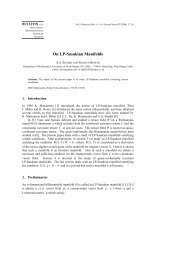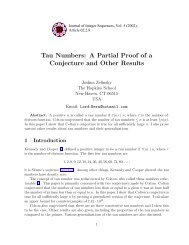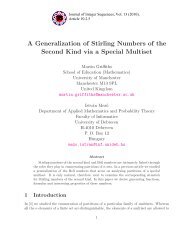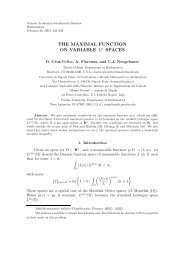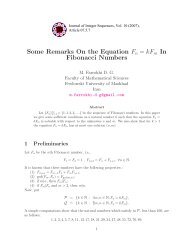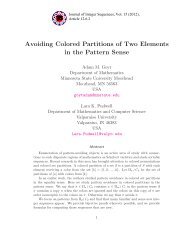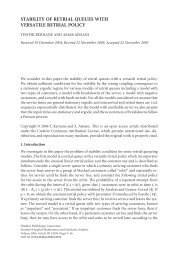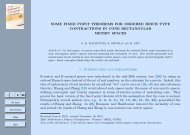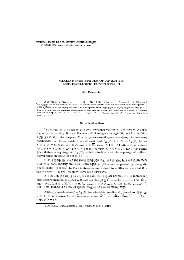the law of the iterated logarithm for locally univalent functions
the law of the iterated logarithm for locally univalent functions
the law of the iterated logarithm for locally univalent functions
You also want an ePaper? Increase the reach of your titles
YUMPU automatically turns print PDFs into web optimized ePapers that Google loves.
362 I. R. KayumovApplying <strong>the</strong> <strong>law</strong> <strong>of</strong> <strong>the</strong> <strong>iterated</strong> <strong>logarithm</strong> <strong>for</strong> lacunary series [10] it is easyto show that ifB 2limr→1 log ( 1/(1 − r) )exists <strong>the</strong>n <strong>the</strong> equality in (2) holds. O<strong>the</strong>r examples which show that (2) is sharpcome from <strong>the</strong> <strong>the</strong>ory <strong>of</strong> Julia sets. The idea <strong>for</strong> using Julia sets in <strong>the</strong> <strong>the</strong>ory <strong>of</strong><strong>univalent</strong> <strong>functions</strong> is due to Carleson and Jones [2]. They conjectured that <strong>the</strong>basin <strong>of</strong> attraction <strong>of</strong> infinity <strong>for</strong> an iteration z 2 + c <strong>for</strong> some c maximizes β 0+ (1)in <strong>the</strong> class Σ.Let F (z) = z q + a q−1 z q−1 + · · · be a polynomial <strong>of</strong> degree q ≥ 2 andbe <strong>the</strong> basin <strong>of</strong> attraction <strong>of</strong> ∞ <strong>for</strong> F .Ω = {ζ : F on (ζ) → ∞ as n → ∞}Theorem 3. Let Ω be a simply connected John domain. Thenσ 2 (0+) = σ 2 = lim supr→1B 2log ( 1/(1 − r) ),where B 2 = ∑ |a k | 2 r k ; a k are <strong>the</strong> coefficients <strong>of</strong> log f ′ and f is <strong>the</strong> con<strong>for</strong>malmapping from D − = {|ζ| > 1} onto Ω.Pro<strong>of</strong>. Our main idea is an approximation <strong>of</strong> <strong>the</strong> function log f ′ by lacunaryseries. Letψ(ζ) = log F ′( f(ζ) ) ∑q−1qζ q−1 =k=1log f(ζ) − ζ kζ∞∑= b j ζ −j .j=0It is known [7] thatlog f ′ (ζ) = −∞∑ψ(ζ qk ) = ϕ(ζ) + g(ζ),k=0where g(ζ) = ∑ ∞ ∑ ∞j=N+1 k=0 b jζ −jqk and ϕ(ζ) = ∑ N ∑ ∞j=0 k=0 b jζ −jqk . Fixingε > 0, we will show that <strong>the</strong>re exists N = N(ε) such that |ζg ′ (ζ)| ≤ ε/(|ζ| 2 − 1).From Pommerenke’s result [8, p. 100] it follows that ∑ ∞j=0 |b jk| 2 j 1+α < +∞ <strong>for</strong>John domains, where b jk are <strong>the</strong> Taylor coefficients <strong>of</strong> log(f(ζ) − ζ k )/ζ . This



